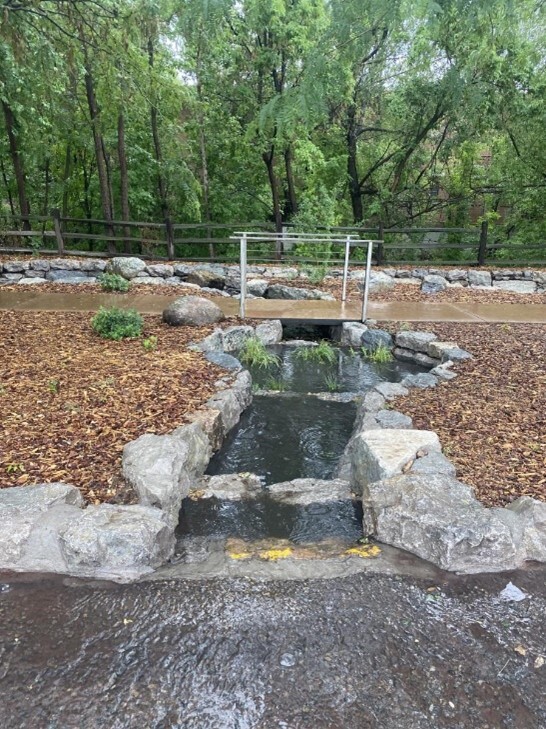Water in Santa Fe
As climate change turns up the heat in the West, cities like Santa Fe are working hard to develop innovative solutions for water conservation and management. While drought persists in New Mexico, Santa Fe is building up its climate resilience to protect and preserve its water resources, ensuring a future that can both accommodate growth and keep the water flowing for all.
Stormwater Management
Managing water effectively is key to building climate resilience. Santa Fe receives most of its rainfall during intense and infrequent precipitation events. When it rains, stormwater can carry trash, fertilizers, car oil, pet waste and other pollutants into our waterways – unless that water is able to soak into the ground as close to the source as possible. Stormwater filtering sites can help to absorb stormwater and filter out pollutants.
In collaboration with the Environmental Protection Agency, the City developed a stormwater management plan in 2019. As part of this re-imagining of the City’s stormwater policy, 15 stormwater filtering sites (and counting) have been installed on City properties. These sites absorb two million gallons of stormwater per year and provide many other benefits, including: erosion control, wildlife habitat, pollution reduction, shade, and natural beauty.
Rain gardens are a prime example of an effective stormwater filtering site. They allow water to slowly infiltrate into the ground -keeping pollutants out of the Santa Fe River- and help us retain groundwater fed by Santa Fe’s aquifer. Rain gardens also help reduce urban heat by lowering reflectivity (known as albedo) and increasing evaporative cooling. The City and its partners, including the Santa Fe Watershed Association and Keep Santa Fe Beautiful, have built 21 rain gardens since 2012.
Water Conservation
Alongside water management, conservation is an important strategy for protecting and preserving water resources. Santa Fe has been working tirelessly on water conservation for many years and continues to ramp up its actions to ensure a resilient future. Just recently, in January of this year, the City entered an agreement with more than 30 other municipal and public water providers to implement conservation actions, programs, and policies that will reduce water usage and conserve the Colorado River system- including vital sources like Lake Powell and Lake Mead.
The City has already seen an impressive decrease in water usage since it began its water conservation efforts. Overall, the City of Santa Fe has lowered its GPCD (Gallons Per Capita Per Day) by more than 30% since purchasing the City of Santa Fe Water Company (CSFW) in 1995, despite a steady increase in the City’s population. Reducing usage is key to building up resilience, as it maintains the backup water supply needed for times of drought and minimal rain. In addition to conservation, maintaining a diverse portfolio of supplies, including two different river sources, is essential to recovering groundwater levels. Since 2010, the City’s groundwater wells have been recovering, an indicator of effective usage reductions.
Right now, the City is developing a strategic plan for conservation and management, the Water 2100 Plan. This plan will build on the SF Conservation and Drought Management Plan, and outline actions and policies for protecting water resources until the year 2100. The plan is expected to be finished in 2024.
Call to Action
Water conservation starts at home! Use these tips to do your part and help Santa Fe’s water systems remain healthy, resilient, and efficient.
- Take advantage of rebates for:
- Water efficient indoor appliances
- Rain barrels and larger rain cisterns
- “Laundry to Landscape” gray water redirection system
- Outdoor watering equipment
- Use the EyeOnWater app to monitor your water usage and detect leaks
- Utilize Save Water Santa Fe’s water saving tips, tools, and resources for both residents and businesses
Previous Post
Reducing Waste and Keeping Santa Fe Clean
Next Post
How Santa Fe Is Contributing to Climate Change – And What We Can Do About It (Part 2)


